 |
Consequences of Vatican II
Better ICEL, Better Hope?
Fr. Stephen Somerville
On the verge of summer of this year 2006, the largest English-speaking country in the world (the USA) approved by a large majority vote (85 %) of its Catholic Bishops, the new translation of the “order of Mass” from Latin to English. Will this decision impact on the relation of Traditional Catholics to their majority brethren in the Conciliar Church? Will it narrow or widen the divide? Will it reduce the area of conflict?
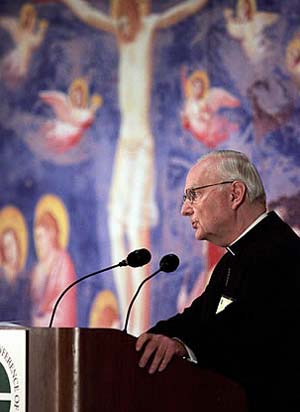
Bishop Donald Trautman, chair of the US. Bishops' Committee. The new ICEL changes were approved in a vote, 184 - 8, in Los Angeles, June 15, 2006
The Tidings online, June 23, 2006 |
For example of a benefit, in the newly approved version, when the priest says “The Lord be with you,” the people are to respond, “And with your spirit” (instead of “And also with you”). This word spirit affirms the existence of the soul. In the Confiteor, the sense of sin is fortified by these words, newly restored: “Through my fault, through my fault, through my most grievous fault.” Other detail improvements could be pointed out.
One could counter, however, that the moves are merely rearranging the deck chairs on the Titanic. The essential thing is that worship in the renewed Conciliar Church still today remains gravely damaged on account of the Latin Roman Missal published back in 1969 by Paul VI. The damage was aggravated by the deplorable English translation of it done by ICEL, a translation happily on the point of being replaced by the “new ICEL,” under its recent Vatican appointees, eager now to translate more faithfully.
A major foundation of this new zeal for liturgical fidelity was an “Instruction” from the Vatican, issued March 2001, and titled Liturgiam authenticam (LA). Its topic was precisely rules for the translation of the Liturgy. In my opinion, those rules should have been laid down back in 1968 when the new liturgy began to appear. I would even have suggested that the Vatican itself and not the ICEL should have translated the new Liturgy into the principal modern languages. The Vatican would not dream of submitting its papal encyclicals and other major governing documents to the whims of some committee answering to Bishops. Now, even more important than encyclicals to the life of the Church is the Mass. It is the weekly and daily public affirmation of the Church’s being and belief. Moreover the Vatican has a team of professional translators for the major languages.
Why did the Vatican not itself provide us with a prompt and professional English translation? Was it too preoccupied with the turbulent happenings in the wake of Vatican II? Was it bewildered in the face of a task that had never arisen before? Was it a secret conviction that the Holy See should not even dream of translating that most holy rite that has sustained the Church and her martyrs for fifteen centuries plus? I do know that some English-language Bishops (one of them told me so in 1964 at an early ICEL meeting) put their heads together in 1963, probably over a cappuccino on the Via della Conciliazione in dear old Roma. And they said, “What if the English speaking Catholics get flooded with ten conflicting translations of the Mass? What if we can’t agree how to recite the Creed?” And so ICEL was born, not a Vatican creature, but a creation of Bishops.
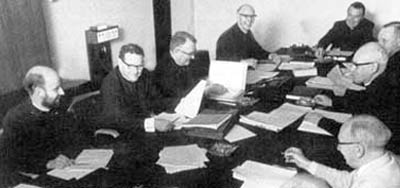
Fr. Somerville, first at left, in a meeting of the early ICEL
London, September 1969 |
The faulty translations of liturgy, especially those in English by ICEL, were what later helped drive Rome to publish Liturgiam authenticam, in an attempt to restore order.
But wait! Precisely what Latin text was to be given to ICEL to work on? What copies of the Latin Liturgy would Rome entrust to ICEL? Would it be the original Latin Liturgy of the Early Church, of the Fathers, of Gregory the Great and Augustine and all that blessed band? If not, would it be the famed Missale Romanum of the Trent Council and of Pope St. Pius V? But this would be impossible! The Church is now `coming out of the 1960s and the Second Vatican Council! Shall not this Latin rather be the New Missale Romanum of Paul VI? Surely it would be this! And does this not embody “the fruit of the liturgical renewal just recently brought forth?” (LA n.20) Would any of its changes and modifications not be such that “the good of the Church genuinely and certainly requires them”? (Sacrosanctum Concilium n. 23) Would not the changes “grow organically from forms already existing”? (ibid. )
We know very well that the new liturgical standard bearer of the Conciliar Church is the 1969 Missale Romanum of Paul VI. This means that all the changes and variations brought into the liturgy (not excluding, of course, the books of the other Sacraments and Rites) should be changes such as were supposedly envisioned by the Fathers of Vatican II, and vaguely described in the major Liturgy document of Vatican II, Sacrosanctum Concilium, (SC), the Constitution on the Liturgy, and quoted above: changes such that “the good of the Church genuinely and certainly requires;” changes that “grow organically from other forms already existing.” (SC, ibid.)
Revolution in the Church
Do these positive intentions describe well the practical consequences that came over the Church when the new Missale Romanum (1) and its new Ordo Missae were applied? Sad to say, they do not. The Catholic Church has undergone not a reaffirmation of her glorious past but a revolution of her liturgy. The revolution was so violent that the churches, the religious orders and the seminaries began rapidly to empty.
1. The Apostolic Constitution Missale Romanum promulgated by Paul VI on April 3, 1969, presented two documents: the Institutio Generalis Missalis Romani [General plan for the Roman missal] and the Novus Ordo Missae [New ordinary of the Mass].
The Institutio includes 341 articles in which the new rites are minutely explained. It also establishes theoretical and practical principles for the Eucharistic celebration. The Ordo Missae includes the new text of the Mass and the new rubrics for its celebration.
Let us consult the teaching of the Instruction Liturgiam authenticam, on the rules for translating the Liturgy and Scripture.
LA says that translating the liturgy is not creative innovation, but rendering the original text faithfully and accurately. This is a serious principle of liturgy. There is an axiom: “Liturgy is not created but received.” It is a given sacred. It is performed, repeated, carried out regularly and without alteration. This has been true of all the Catholic rites in all ages. Never in Catholic History has there been any sudden, major change in her liturgy, never, until Vatican II.
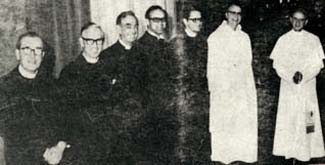
The Protestant theologians who helped Bugnini rewrite the New Mass pose with Paul VI |
Yet, after Vatican II approved Sacrosanctum Concilium in 1963, there began a tremendous revolutionary change in the Catholic Liturgy, brought about by the so-called Consilium group under Fr. Annibale Bugnini, (later Archbishop). It was a veiled but gross violation; it was not cautious and conservative change as expected by most of the Bishops. It was a harmful “innovation” (LA, n. 1) and not a “faithful and accurate rendering” of the ancient Missale (cf. LA, n.20).
If all this is so, why was the Bugnini group allowed to compose that radically new and suspect liturgy? Why did the Liturgy fall into the hands of revolutionaries?
The sad truth is that influenced by the liberal-modernist movement many Catholics and especially those in the Church leadership, the theologians, the leading Bishops, and most crucial of all, the Popes from John XXIII, appeared to be falling from the Faith. The time to strike, but strike covertly, came in 1958 when Pope Pius XII died. After some alleged struggle in the conclave, Pius XII was replaced by Cardinal Roncalli, a “favorite grandfather” figure, who had a reputation for supporting Modernism, which is a name not for a mere style but for a heresy. St. Pius X had described it as the “synthesis of all heresies.” Jesus clearly predicts a great loss of faith’ (LK 18:8), and St. Paul foretells a great revolt or apostasy (2 Thess 2). Other prophets tell of a collapse of faith in the 20th century, which seems clearly to have come. Our Lady at La Salette is quoted, “Rome will lose the Faith.”
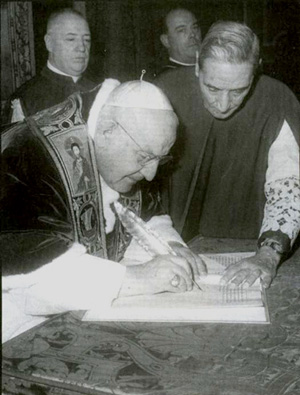
On December 25, 1960, John XXIII signs the Constitution Humanae salutis, convening Vatican Council II
30 Giorni, July 2000 |
By the year 2000 the liturgical and ecclesial collapse, on the one hand, and the small but strengthening traditionalist movement, on the other hand, insistently demanded of the Vatican stronger measures, including a return to Catholic traditions of worship. Accordingly, the writers of the Liturgiam authenticam instruction had to deal with the weaknesses of the new liturgy of Paul VI without causing a loss of face, without admitting the serious mistakes of Vatican II, without openly denouncing Annibale Bugnini (who in 1976, was promoted to Apostololic pro-Nuncio in order to be quietly removed to Iran).
How does LA deal with the crisis? LA skillfully arranged the text to begin with the title words, Authentic liturgy. This evokes “authenticity,” genuineness, respect for ancient authority, for tradition, and fidelity. It suggests a serious effort to restore what the revolution had damaged. But in order to placate and reassure the modernist and progressivist elements who are certainly still dominating the Church, those pro-tradition remarks are always partnered with calls for renewal, for “adapting the ancient spiritual tradition to the genius of the various peoples” (LA n. 1). This is really a meaningless bit of puffery, but good window dressing. The duty of all the peoples is to adapt themselves to Jesus Christ and His Gospel, a task faithfully achieved in the Old Mass and Sacraments.
For they say, and do not (Mt 23:3)
We are facing a Catholic collapse through the past four decades since the Vatican II Council (1965), a collapse especially evident in the Liturgy. Let us ask a blunt question: Did the Vatican authorities suffer any embarrassment, or regret, or guilt?
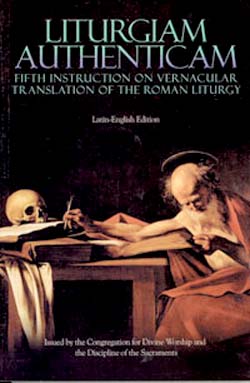
LA, the fifth translation, attempts to correct the liturgical disaster |
As far as I can see, the strongest Vatican document since the collapse started is precisely Liturgiam authenticam. It runs over 50 pages, denouncing the errors in current translations of the post-Vatican II liturgy and insisting firmly on better rules for rendering into English the official Latin Mass and Sacraments, along with the denunciation elsewhere of abuses in celebration. With this supposedly corrective document, the Vatican officials appeared to be hoping to rebuild the Catholic House, so gravely damaged by falling Catholic standards. It would be a partial “reform of the reform.” It would make the Mass sound more attractive and reverent.
Let me explain. LA features two strong and opposite movements. The first is preserving, looking to the past; the second is adapting, looking to the future. Preserving evokes words like respect, reverence, fidelity, tradition, authenticity, indefectibility, wholeness and intactness. Adapting calls forth reform, change, renewal, revision, organic growth, inculturation, pastoral necessity. All these words occur in LA.
Its very first sentence says, “preserve with care the authentic liturgy flowing from ancient tradition” (LA, n. 1). I understand this indeed. The Roman Mass prayers date back mostly around fifteen centuries, and some even more. Holy Church had always maintained this Holy Mass in a holy language, holy vesture, holy buildings, holy music and above all, in holy hearts shaped by Baptism, a Catholic culture, catechizing, regular Confessions, and myriad sources of God’s sanctifying grace. I knew it. I was there. I was raised in it, attending those Catholic schools and brimming Catholic seminaries. In the mid-1950s, I was ordained a young priest for it. Yes, indeed, we should “preserve with care that authentic Catholic liturgy.”
But forthwith LA adds, “Adapt [the liturgy] to the genius of the various peoples with the purpose of renewal [intended by] the Council.” This I do not understand! What is that “genius of various peoples”? Must the one Catholic liturgy express every national culture? Jesus says, “Preach the Gospel (not adapt it!) to every creature” (Mk 16:15), and St. Paul adds that we are “predestinated to be made conformable to the image of His Son” (Rom 8:29). It is the peoples, and not the liturgy, who must conform.
Revolution in Liturgy
Furthermore, was “renewal of the liturgy intended by the Council”? It is easy to say so. But what is actually said by the Council is there must be no innovations unless the good of the Church genuinely and certainly requires it (SC, 23). In the Novus Ordo Missae that appeared in 1969 (and is still in rule), huge portions of the Tridentine Mass (the Offertory, Roman Canon, scores of orations) largely disappeared. This is not renewal or organic development. It is obliteration.
Organic development of liturgies is to be measured rather in centuries. It is not a quick fix by a council committee. As for the vague term “renewal” or renew, it is never used in the Gospel; it is used only four times by St. Paul and each of these denotes an action of God, not of man. I think that I see “renewal” now as a great Vatican bluff word of the post-conciliar period, suggesting that the “Holy Council,” and, the Holy Spirit, be credited with the recent so-called “renewal” of Church and liturgy. Instead of renewal, it has been an immense degradation.
The writers of LA continue to put a bold front on their elaborate attempt to vindicate the Vatican II liturgy. It says, “(Thus) began, under the care of the Supreme Pontiffs, the great work of renewal of the Roman rite [and its translation] with the purpose of … that renewal … a foremost intention of the Council” (LA, n. 2).
Let me comment on this phrase “under the care of the Pontiffs?” Yes, indeed. The Freemasons had been scheming for a century to get a liberal, modernist or progressivist Pope elected. After infiltrating many of their members into the priesthood and the episcopacy, it seems they finally succeeded with John XXIII. He and his successors consistently fostered the ideals of Freemasonry. They also mostly chose progressivist candidates for future cardinals. Paul VI forbade the older cardinals to vote for future popes, the better to influence future elections.
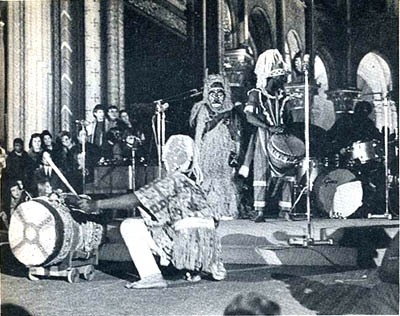
Everywhere, the New Liturgy has spawned abuses, such as those shown above during a Mass in Saint Germain des Pres, Paris, in 1969
Informations Catholiques Internationales, March 1969 |
Was this planned renewal a “foremost intention of the Council”? It was of the Council leaders, doubtless so. As for the rank-and-file Bishops who care about the Mass, most of them certainly did not plead for a radically different Mass and the wrecking of the Tridentine Mass. And only a small minority wanted an all-vernacular Mass. The Bishops, in sum, were manipulated by the powerful and well-prepared minority in the Council.
Knowing these things as we do, we now hear LA intone: “The liturgical renewal has thus far seen positive results” (LA, 3). I am aghast! That line sounds like “positive peanuts!” Is it “damning with faint praise”? What a pathetic and well deserved evaluation of the tawdry new Catholic liturgy machine! I am not speaking with bitterness. I gave over 30 years of my life as a priest to make the best of the New Mass. I served on several diocesan liturgy commissions, I directed a Cathedral choir, I was editor of a National Missalette. Then, rather suddenly and quite by God’s providence, not by my own art, I saw once again (O bless my soul!), I saw the surpassing truth of the Old Mass. And I returned to it.
LA (§ 4) now speaks of the Catholic liturgies of the East “of venerable antiquity,” of that “tradition received through the Fathers from the Apostles,” which must be “preserved whole and intact.” And rightly so! Here is the Vatican affirming with high authority that the Catholic liturgies trace back to the very Apostles. Yes, indeed. And such antiquity demands preservation, not replacing. “If it works, don’t fix it!”
Yet LA now shifts into reverse, and calls for “revision … in accordance with sound tradition”! But tradition is precisely something that one does not revise. Would you re-write Charles Dickens’ A Christmas Carol? Or repaint the Mona Lisa? Or change a Mass that has been a glorious fixture for fifteen hundred years plus?
The Vatican Congregation for Divine Worship (CDW) is the true name of our antagonist behind LA. Their members are the iconoclast striving to conceal, or if possible to justify, the huge act of liturgical destruction perpetrated by them and their earlier collaborators about 35 years beforehand, when they revised The Roman Rite virtually out of existence by their bold changes.
Worldly motives for change
Did they innocently miscalculate their consequences? Or were they rather following a long-thought-out policy of ecumenism and protestantization in order to gain secular approval from non-believers who might ridicule the Catholic Church? Were they expecting the Zionist and Socialist and Masonic forces to achieve in an early future the One World Government in that much-touted New World Order, with a suitable One World Religion to match? They would rather join it than fight it
The more we ponder these questions, the harder it becomes to expect an easy reconciliation between the Vatican, spellbound by such secular forces, and the traditional Catholic remnant, striving to maintain the old Missale Romanum and Catholic traditions.
Let us conclude our reading between the lines of Liturgiam authenticam by one more return to § 20. In it, our Liturgy is being highly praised as the fruit of centuries of transmitting the Faith from the time of the Fathers. Then, suddenly, it is called the “fruit of the liturgical renewal just recently brought forth,” meaning the new liturgy and new missal put together by the Consilium committee. It seems to me that there is little reverence, authentic flow, or organic vital bond between the two: the Missale Romanum of Trent and the Missale Romanum of Paul VI.
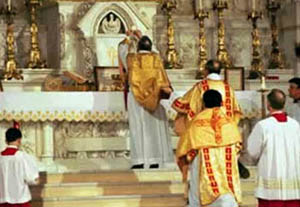
The Mass of all ages (above), reverent in all aspects, is poorly replaced by the New Liturgy, even in a supposedly conservative version.
Below, Bishop Trautman con-celebrates with four priests
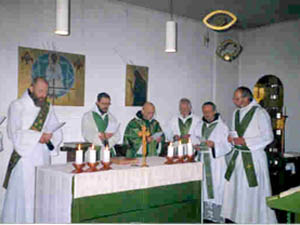 |
I have quoted LA above (n. 20), that the “translation is not a work of creative innovation [but] rendering faithfully the original [Latin] texts.” I shall now replace a few small missing words, words that I actually deleted from LA, because they were obscuring and confusing this truth, so that readers would likely not notice the enormity of what the new liturgy has done. Here now, is the text with the restored small words: “The translation is not SO MUCH a work of creative innovation AS IT IS OF rendering faithfully the original texts.” Behold! Innovation is here cleverly and unobtrusively justified, as long as there is not so much of it as there is of a faithful rendering. And who will measure this?
I have been trying to show my readers, sometimes with blunt language, that the New Mass is a destruction, an obliteration, a sacrilege, a violent revolution. It is certainly not a careful and reverent retouching of the Roman Missal, even if the necessity of this were conceded. Most conciliar Catholics do not see or grasp this, from long habituation to the new ways and the restoration of sufficient bits of tradition, the better to deceive.
I must conclude: Liturgicum authenticam, for all its wise words on translation, is a great deception. It stands by that re-write (in Latin) from modernist and ecumenical minds, of the whole Roman Liturgy. Amid all the surviving fragments of truth or worship or goodness, there is an overarching trend, or tendency, toward heretical Modernism. To say this liturgy in Better English is all the more deceptive. Preserve, Yes. Adapt, No.
Remember that great maxim, “Lex orandi, lex credendi” – The law of praying determines the law of believing. Pray the new conciliar Liturgy enough Sundays, enough months and years, and you will believe according to the new conciliar faith, which has led a large majority of Catholics astray. Astray, or … away.
We should applaud and respect the good words of LA on how to translate. Let us heed them when translating. But let us demand good words of Latin in the first place, not bad words of Modernism, be the Latin of it ever so elegant.
For they say, and do not. (Mt 23:3).

Posted August 31, 2006

Related Topics of Interest
 The The Bugnini Liturgy and the Reform of the Reform The The Bugnini Liturgy and the Reform of the Reform
 The Catholic Revolution: New Wine, Old Wineskins and Vatican II The Catholic Revolution: New Wine, Old Wineskins and Vatican II
 Is the Catholic Crisis Really Explained? Is the Catholic Crisis Really Explained?
 The Canonization of Wojtyla - the Moral Free Pope The Canonization of Wojtyla - the Moral Free Pope
 On Resisting the Novelties of the Conciliar Church On Resisting the Novelties of the Conciliar Church
 The New Mass:A Flavor of Protestantism The New Mass:A Flavor of Protestantism
 The Bad Effects of the Papal Apologies The Bad Effects of the Papal Apologies

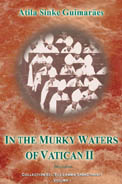

|
Vatican II | Hot Topics | Home | Books | CDs | Search | Contact Us | Donate

© 2002-
Tradition in Action, Inc. All Rights Reserved
|
 |
|